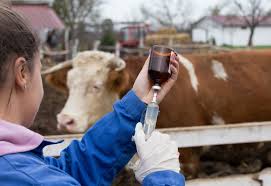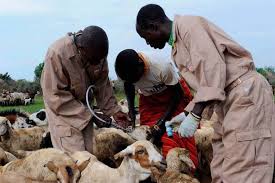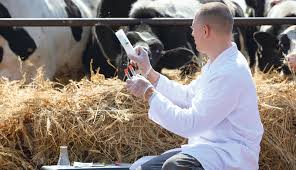After a successful disease diagnosis, the next step is to cure the disease using an appropriate treatment regimen. The recommended treatment depends on the type and severity of the disease affecting the animal.
In most cases, major symptoms are treated alongside the disease-causing agents for a more comprehensive approach to recovery.
However, different diseases present varying clinical manifestations, requiring different treatment approaches and medications. In critical conditions, fluid and/or blood transfusions may be necessary before recovery is achieved.
Read Also: Various Types Of Fruits And Their Nutritional Value
Routes of Drug Administration in Livestock

Several routes are used for administering veterinary drugs. The choice of route and technique depends on factors such as animal species, physicochemical properties of the drug, drug formulation, and the disease being treated. It is essential to follow the manufacturer’s recommendations.
1. Oral Route: This involves administering drugs through the mouth. It is commonly used for antidiarrheals, anthelmintics, and supplements. Care must be taken to prevent drugs from entering the trachea. Oral drugs are exposed to digestive enzymes and microorganisms, which may affect drug activity.
Drug absorption through this route is generally slower compared to other routes. Drugs administered in feed and water also fall under this category. Drug formulations for oral administration include tablets, boluses, suspensions, syrups, and pastes.
2. Parenteral Route: This route involves using a hypodermic needle and syringe to introduce medication between the skin and the gastrointestinal tract. It is often used when rapid drug absorption is required. Common parenteral routes include:
i. Intramuscular (IM): Administered into the muscle for faster absorption.
ii. Intravenous (IV): Directly introduced into the bloodstream for immediate effect.
iii. Subcutaneous (SC): Injected under the skin for slower absorption.
iv. Other routes: Intraperitoneal (IP), intrathoracic, intracardiac, intradermal, and epidural administration.
3. Topical Route: This involves applying drugs directly to the skin or mucous membranes. Examples include intrauterine, intravaginal, ocular, rectal, preputial, sublingual, and intranasal applications. Common topical formulations include ointments, creams, pastes, dusting powders, lotions, and sprays.
4. Pulmonary Route (Inhalation): This is used for gaseous drugs or volatile agents, which are rapidly absorbed through the lungs. Nebulizers or anesthetic machines are typically used for administration.
Read Also: Cultivation Methods For Different Fruit Trees And Bushes
Drug Administration Techniques in Livestock and Their Limitations

1. Oral Administration
i. Includes administration in feed or water, as well as tablets, boluses, pastes, and drenches.
ii. In-feed administration is simple but depends on the animal consuming the entire dose.
iii. Absorption is slower compared to injections and can be affected by food intake.
iv. Drug destruction in the digestive tract or incomplete absorption may occur.
2. Intravenous Injection
i. Introduces drugs directly into the bloodstream, ensuring 100% bioavailability.
ii. Commonly administered into the jugular vein.
iii. Provides the fastest effect but requires restraint and careful administration.
iv. Risk of infection and potential pain during injection.
3. Intramuscular Injection
i. A second-fastest route for drug absorption.
ii. Allows for slow-release “depot” injections.
iii. Can be painful and may cause tissue damage or necrosis.
iv. Commonly administered by hand injection, pole syringe, or remote darting.
4. Subcutaneous Injection
i. Used for injecting relatively large volumes.
ii. Absorption is slower than intramuscular injections.
iii. May not be suitable for irritating drugs.
5. Administration by Needleless Injector
i. Used for local anesthetics before procedures like castration and tail docking.
ii. Reduces the risk of infection but has limitations in drug volume and frequent reloading.
6. Topical Administration
i. Includes skin applications and mucous membrane treatments.
ii. Used for local anesthesia and mastitis treatment.
iii. Intramammary infusion is a specialized form of topical administration.
Local and Regional Administration
i. Used primarily for local anesthetics during procedures like lameness assessment, toe amputation, teat surgery, and cesarean section.
ii. Epidural anesthesia involves injecting drugs into the epidural space.
Veterinary Drug Preparations
Veterinary drugs come in various forms depending on the target species and disease being treated. Common forms include tablets, capsules, creams, emulsions, ointments, injections, powders, gels, sprays, boluses, and drops.
To achieve the desired effect, the drug must be administered via the appropriate route as per the manufacturer’s recommendations.
Classes of Veterinary Drugs and Examples

Veterinary drugs can be classified based on the organism they act upon or the organ they target. Below is a classification based on disease-causing agents:
1. Antibacterial: Oxytetracycline, Streptomycin, Procaine Penicillin
2. Antiprotozoan: Diminazene aceturate, Amprolium, Homidium bromide
3. Anthelmintics: Levamisole, Albendazole, Pyrantel pamoate
4. Antifungal: Ketoconazole, Griseofulvin, Nystatin
5. Antidiarrheals: Methoscopolamine, Diphenoxylate, Kaopectate
6. Anti-inflammatory/Analgesics: Dexamethasone, Phenylbutazone, Acetylsalicylate
Ethno-Veterinary Medicine and Traditional Practices
Livestock farmers in Nigeria and other parts of Africa have historically relied on locally available plants and herbal preparations for animal treatment. This indigenous knowledge system, known as ethno-veterinary medicine, includes traditional beliefs, skills, and practices for animal healthcare.
Ethno-veterinary medicine is cost-effective and relies on local resources but faces challenges such as lack of documentation, difficulty in standardization, and seasonal unavailability of medicinal plants.
Comparison Between Ethno-Veterinary and Orthodox Veterinary Medicine
| Ethno-Veterinary Medicine | Orthodox (Western) Veterinary Medicine |
|---|---|
| Indigenous, farmer-oriented | Developed by scientific research |
| Passed down through generations | Communicated by researchers to veterinarians |
| Compatible with local resources | Often dependent on external inputs |
| Poorly documented and researched | Well-documented and researched |
| Slower in showing effects | Faster and more predictable results |
| Specific to local conditions | Generalized recommendations |
Do you have any questions, suggestions, or contributions? If so, please feel free to use the comment box below to share your thoughts. We also encourage you to kindly share this information with others who might benefit from it. Since we can’t reach everyone at once, we truly appreciate your help in spreading the word. Thank you so much for your support and for sharing!

